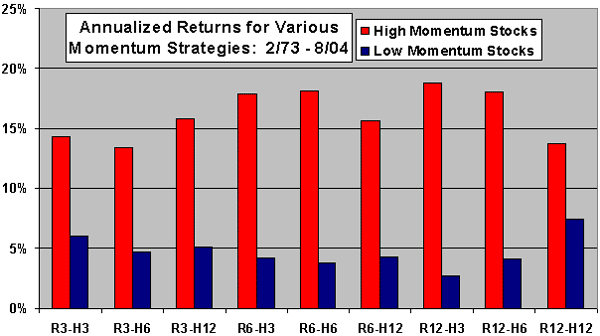Do commodity futures exhibit short-term momentum and long-term reversion, as do stocks? In the August 2006 version of their paper entitled “Momentum Strategies in Commodity Futures Markets”, Joelle Miffre and Georgios Rallis examine the profitability of 32 momentum (short-term continuation) and 24 contrarian (long-term reversal) strategies in commodity futures markets. The momentum strategies buy (sell) recently outperforming (underperforming) commodity futures and hold resulting long-short portfolios up to 12 months. The contrarian strategies buy (sell) the commodity futures that underperformed (outperformed) in the distant past and hold resulting long-short portfolios for periods of two to five years. All strategies trade liquid futures contracts with nearby maturities involving 31 commodities, unimpeded by short-selling restrictions often encountered in equity markets. Using futures contract price data spanning 1/31/79-9/30/04, they conclude that:
- Contrarian (long-term reversal) strategies do not work for commodity futures. There is no evidence that past winners (losers) turn into losers (winners) over ranking and holding periods of two to five years. In fact, past losers tend to keep losing.
- There are 13 profitable long-short momentum strategies for commodity futures with an average annual return over the entire sample period of 9.38%, compared to loss of 2.64% for a long-only equally-weighted futures portfolio. Shorting past losers drives profitability. While these results exclude transaction costs, such costs are very low for commodity futures contracts.
- The most profitable momentum strategy (12-month ranking period, one-month holding period) offers an average annual return of 14.6%, but it is also the second most volatile strategy with a annualized standard deviation of 25.6%.
- Commodity futures momentum returns do not diminish over the sample period.
- Successful momentum strategies tend to buy contracts in backwardation and sell contracts in contango.
- The correlation between commodity futures momentum returns and the returns of stocks and bonds is low, making commodity futures momentum portfolios good risk diversifiers.
- The correlation between commodity futures momentum returns and the change in the consumer price index is insignificant, indicating that they do not hedge against short-term inflation.
The following chart, taken from the paper, summarizes the average returns for 32 commodity futures long-short momentum strategies based on combinations of four ranking periods and eight holding periods during 1/31/79-9/30/04. It shows that momentum returns are mostly short-term and that, for commodities, there is no significant long-term reversal of momentum.

In summary, commodity futures long-short momentum strategies may offer both good average returns and effective diversification of a stocks/bonds portfolio.